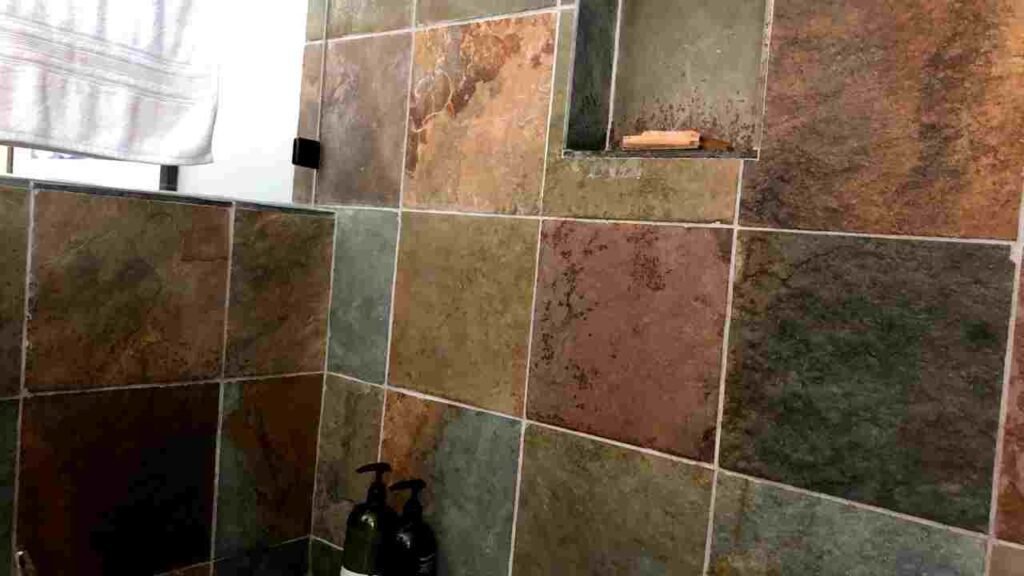
Alright, let’s be honest here. Who has yet to be captivated by the earthy charm of a slate shower, its natural texture offering luxury to your everyday routine? But then you spot the dull, cloudy film tarnishing your beautiful slate tiles. Suddenly, the luxurious experience seems less so. And you can’t help but ask, “How can I restore the glory of my slate shower?”
Well, dear reader, you’re in the right place. Join me on this journey as we explore the best techniques to clean and maintain your slate shower, keeping it as stunning as the day it was installed. Hold tight because it’s about to get wonderfully clean in here!
The Importance of Regular Slate Shower Cleaning:
There’s something special about stepping into a freshly cleaned shower, particularly one adorned with slate tiles. There’s the aesthetic appeal, of course, the way clean slate glistens, showing off the unique blend of colors that drew you to it in the first place. But regular cleaning of your slate shower goes far beyond mere aesthetics.
When we talk about slate, we’re dealing with a natural stone that’s both durable and porous. While it can stand the test of time, it also tends to absorb water and other substances that can cause discoloration and damage over time.
So, you see, by neglecting regular cleaning, we’re diminishing the visual appeal of our slate shower and potentially shortening its lifespan.
But here’s the thing. Regular cleaning isn’t just about preserving your shower’s looks and durability. It’s also about hygiene. A clean shower is healthy and free from mold, mildew, and bacteria that love to grow in damp environments. And let’s be honest, who wants to enter a shower hosting those unwanted guests?
That’s why regular slate shower cleaning isn’t just a chore; it’s a necessity. It’s about maintaining a space that’s not only clean and attractive but also safe and hygienic. Doesn’t that sound like a shower experience you’d want to have?
Preparation: Tools and Materials:
Now that we’re all on the same page about why cleaning our slate showers is a big deal let’s get to the nitty-gritty. It’s time to roll up those sleeves and get our hands dirty – well, clean! But first, we need the right tools and materials for the job.
- Stone Cleaner: This is the main event, folks. A cleaner specifically designed for natural stone, like slate, will clean without damaging your tiles. Always opt for a non-acidic, pH-neutral cleaner that’s gentle on the stone but tough on the grime.
- Soft-Bristled Brush or Sponge: A non-abrasive scrubbing tool is a must. It will allow you to tackle the dirt and stains without scratching or damaging the slate.
- Microfiber Cloth: These are brilliant for wiping down surfaces. They’re soft, super absorbent, and won’t leave any lint behind.
- Sealant (for Slate Tiles): After we’ve done all the hard work cleaning, a sealant will help protect the slate from future stains and damage. Again, ensure you choose one specifically designed for slate or natural stone.
- Bucket and Warm Water: Good old H2O is essential for any deep cleaning session!
- Rubber Gloves: Safety first, people! Protect your hands from the cleaning products and grime you will banish.
Step-by-Step Guide to Cleaning Your Slate Shower:
So, you’ve gathered your materials and are ready to go. That’s the spirit! Let’s jump right into the process and make your slate shower sparkle.
1. Pre-Cleaning Rinse:
Start with a warm rinse to loosen up surface grime. Using your shower head, spray down the entire area, paying particular attention to corners and grout lines where dirt likes to hide.
2. Apply Your Stone Cleaner:
Now, put on those gloves and apply the stone cleaner to your slate. It’s best to work in sections, starting from the top and working your way down to prevent drips.
3. Scrub-a-Dub-Dub:
Grab your soft-bristled brush or sponge and start gently scrubbing. Remember, the aim here is to lift the dirt, not scrub so hard we damage the slate. Always follow the grain of the slate to avoid scratching.
4. Rinse and Repeat:
Once you’ve scrubbed a section, give it a good rinse to wash away the cleaner and grime. If there are still noticeable stains or spots, don’t fret. Just reapply the cleaner and scrub again. Persistence is key!
5. Dry and Inspect:
After you’ve rinsed the entire shower, use your microfiber cloth to dry it off. This is also a good time to inspect your work and tackle any remaining spots.
6. Seal the Deal:
Once you’re satisfied with your sparkling clean shower, it’s time to protect it. Apply your slate sealant according to the package instructions. This step will help guard against future stains and water damage, keeping your slate looking fresh longer.
7. Final Rinse and Dry:
After the sealant has had time to cure (check the package for specifics), give your shower one last rinse and dry.
Preventing Damage:
We’ve done a stellar job cleaning that slate shower, but as they say, prevention is better than cure. So, before we part ways, let’s chat about what NOT to do when cleaning the slate, so you can avoid causing any unintentional harm.
1. Avoid Acidic or Abrasive Cleaners:
First and foremost, steer clear of acidic cleaners like vinegar or lemon juice and abrasive cleaners like scouring powders. They might be great for other household tasks but can damage the slate, causing etching or dullness. Instead, stick to the pH-neutral, stone-safe cleaner we mentioned earlier.
2. Don’t Use Hard Brushes or Scrubbers:
A steel brush or a hard scrubber can scratch and damage your slate tiles. Always use a soft brush or sponge for a gentle yet effective clean.
3. Don’t Neglect Your Grout:
If you’re using grout between your slate tiles, remember that it needs love too! Dirt and mold can build up here, and cleaning can be difficult if neglected for too long. Use a soft brush to scrub the grout when cleaning your tiles gently.
4. Don’t Leave Water Sitting:
Slate is a porous material that can absorb water, leading to water spots or even damage over time. After every shower, consider giving your slate a quick wipe-down to prevent water buildup.
5. Avoid Skipping the Sealant:
A good sealant acts as a barrier, protecting your slate from stains and damage. Take advantage of this step in the cleaning process, and consider reapplying the sealant every six months to a year, depending on usage.
Maintaining Your Slate Shower Post-Cleaning:
Great job on reaching this far! Your slate shower is now sparkling clean, and you’re probably thinking, “How do I keep it this way?” Well, you’re in luck. Here are some handy tips for maintaining your slate shower post-cleaning:
1. Routine Wipe-Down:
Consider giving your slate tiles a quick wipe-down with a squeegee or microfiber cloth after each shower. It takes just a minute but helps to prevent water spots and mineral buildup. Plus, it keeps that just-cleaned shine lasting longer.
2. Ventilation is Key:
One of the best ways to prevent mold and mildew (aside from regular cleaning) is proper ventilation. If you have a bathroom fan, use it. If not, consider cracking a window or door to help reduce humidity after showers.
3. Use a Mild, Stone-Safe Shower Spray:
There are daily shower sprays available that are safe for slate. A quick spritz after your shower can help keep grime at bay between deep cleanings.
4. Spot Clean as Needed:
Got a stain or spot? Don’t wait for your next deep clean. Tackle it as soon as possible with your stone-safe cleaner to prevent it from setting in.
5. Seal Regularly:
Don’t forget the importance of that sealant! It’s not a once-and-done deal. Plan to reseal your slate shower every 6-12 months, or as needed, to keep your slate protected and looking its best.
Conclusion:
And there we have it, folks – a comprehensive guide to restoring and maintaining the natural beauty of your slate shower. We’ve covered it all, from understanding why regular cleaning is essential to cleaning and prevention.
So, armed with your new knowledge and determination, it’s time to give your slate shower the care it deserves. Because at the end of a long day, you deserve a clean, inviting shower to wash your cares away. Here’s to sparkling slate, refreshing showers, and the satisfaction of a well-done job.
